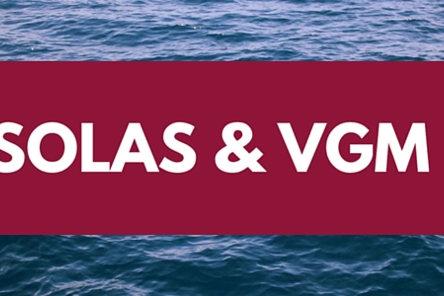1. The Fundamentals:
1.1. What is SOLAS?
The international Convention for the Safety of Life at Sea (SOLAS) in an international maritime treaty implemented by the International Maritime Organization (IMO), requiring Signatory flag states to ensure that ships flagged by them comply with minimum safety standards in construction, equipment and operation. Currently the SOLAS Convention has 162 Signatory flag states around the world. This covers 98.6% of world tonnage. [1]
1.2. Why is SOLAS Necessary & Why Was It Introduced?
SOLAS was originally introduced as a response to the Titanic disaster in 1914. The second treaty came in 1929, the third 1948 and the fourth 1960. The Convention in force today known as SOLAS, 1974, as amended, includes the tacit acceptance procedure. This means that any amendments to the SOLAS regulations will enter into force on a specified date unless objections are received from an agreed number of parties. Due to this, the 1974 Convention has been updated and amended regularly to cover all issues regarding safety at sea, including sea pollution and trading.
With 90% of world trade carried by sea[2], it is important that shipping procedures are as safe as possible. Since the introduction of SOLAS, sea disasters have reduced dramatically. Between the years of 1966-1985, more than 300 ships were lost annually. In 1990, this dropped to below 200, and in the year 2000 fell again to 167 ships lost at sea. In 2014, it was reported that only 75 ships were considered total losses, according to Allianz data. [3]
2. Timeline of SOLAS History

3. What is the IMO?
The International Maritime Organization (IMO) is a specialised agency of the United Nations, established in 1958 with a Convention adopted under the supporters of the United Nations. IMO was first formed to improve safety and security at sea through implementing international regulations that apply to all vessels, with the IMO slogan summing up the objectives: Safe, secure and efficient shipping on clean oceans.
To prevent confusion or conflicting laws between the individual nations, international regulations were created to tackle the global issues faced by the shipping industry.
To begin with, IMO’s mission was intent on developing international treaties concerning safety and prevention of marine pollution. As this was mostly completed in the 1970s, IMO now ensures legislation is up to date and that as many countries as possible take part, alongside involvement in legal matters. Currently, the IMO has 171 countries as member states.[4]

4. Introduction to the New SOLAS Regulation
As of 1st July 2016, the requirements regarding container weight verification and vessel loading will change in accordance with a new SOLAS regulation. As a condition for loading a packed container onto a ship for export, the container must have a verified weight. After the 1st of July, it becomes a violation of SOLAS to load a packed container onto the vessel without a Verified Gross Mass (VGM).[5] This regulation will be applied globally, with maritime authorities of individual nations ensuring that the regulations are being adhered to.
4.1. Why is the New Regulation Being Introduced?
Due to the history of maritime industry accidents caused by unbalanced containers, the SOLAS regulation has been amended to prevent accidents where containers of estimated weight have been loaded onto vessels without due planning, causing instability, costly loss of cargo and vessels, and in some cases, crew fatalities.
- In January 2007, the MSC Napoli came into trouble during a storm, which led to a forced beaching of the vessel. UK investigators weighed 660 containers stowed on deck, and found 20% of these containers weighed over 3 tons more than their declared weights, with the total weight of all containers being 312 tons over what had been declared.
- February 2011 saw an overloaded container weighing 28 metric tons break free form a crane at the Port of Darwin, Australia. The container fell 40 feet, narrowly missing two workers, with the weight reported on the cargo manifest as 4 metric tons.
- Later that year in June 2011, a ship with 168 containers overturned while at berth in Algeciras. When investigated, 1 in 10 containers were overloaded, each weighing up to 7 times its declared weight, and all together weighing four times the combined weight shown on the load.
It is a fair assumption that some shippers underestimate the weight of the containers in order to avoid additional charges, resulting in the vessel stow plan being weighted unevenly. To prevent cargo accidents caused by overloading containers, the SOLAS Convention, 1974 has been amended, so that shippers need to provide a VGM for every container shipped. On July 1 2016 this will become international law under the IMO, and national law for the 162 Signatories to the SOLAS Convention.
4.2. Basic Principles
- A packed container should not be loaded onto a ship that is subject to SOLAS regulations unless the Master or his representative and the terminal representative have obtained in advance of loading the Verified Gross Mass (VGM) of the container. The data to be provided to the carrier will consist of the VGM and the shippers (individual on behalf of the shipper) authorized signature (can be electronic).
- Responsibility for obtaining and documenting the VGM of a packed container lies with the shipper.
- Two permissible methods for weighing: 1) weighing the container after it has been packed; or 2) weighing all cargo and contents of the container, and adding those weights to the container tare weight posted on the container door.
- Estimating weight is not permitted, and the party packing the container may not use weights provided by others; there is no exception for co-loaded containers.
- A carrier may assume a shipper’s valid, signed VGM to be accurate.
- In the absence of a signed VGM, a packed container may be weighed on certified equipment at the port; but may not be loaded aboard ship without a VGM.
- Terminals and carriers will need to agree on and implement processes for weighing packed containers arriving without a valid VGM and using those weights in the vessel stow plan.
- If a packed container is weighed at the load port, that weight is to be used for vessel stow planning.
- Vessel stow plans should use verified weights for all packed containers loaded
- Carriers will not load containers without having a VGM.

5. How to Meet the Mandate
It is the responsibility of the shipper to ensure the container is weighed and verified. In addition to the weight, the documents will need a signature of a person, rather than a company name. This can be obtained electronically, as long as there is a first and last name appearing on the document. If the VGM documentation is not supplied, shippers risk missing the intended sailing as any containers without will not be allowed on the vessel. Under the SOLAS amendments there are two methods to weighing the containers:
Method 1:
This requires weighing the container and contents once it has been packed. For this the container should be placed on a weighbridge, with the weight of the truck, chassis and fuel subtracted to allow you to work out the loaded weight of the container.
Method 2:
This requires the shipper to weigh all the cargo within the container before it has been packed, including goods, packaging, and dunnage, and add this amount to the tare weight of the container to ascertain the total weight. This method however would be impractical for weighing certain cargo such as scrap metal or cargo in bulk which could be difficult to weigh individually.
The methods used may vary depending on the carrier used, and for both methods, the weighing equipment must meet national certification and calibration requirements. A packed container may be weighed at the port using certified equipment, however, if the terminal doesn’t have this equipment to provide a VGM the container will not be loaded onto the vessel.
Packed containers entering through a U.S terminal gate via truck (i.e. off -dock rail, local export cargo) can be weighed by the terminal. The carriers can use this weight as the VGM submission by the shipper. Packed containers that move via rail intermodal received at a terminal (i.e. on-dock rail) will already have Gross Cargo Weights, as required under the Intermodal Safe Container Transportation Act (ISCTA). These are passed from the shippers loading facility to the trucker, and then to the carrier (for inland rail units only) for safe rail transport and terminal handling. The carrier, on behalf of the shipper, will add container tare weight to the Gross Cargo Weight, and submit the total as VGM to loading ports.
Whilst the regulations will be enforced immediately from July 1, there will be a grace period of three months, subject to individual nations to put the appropriate measures in place. For containers packed prior to July 1, but shipped on or after this date, the three months’ flexibility will allow containers to reach their final port without a VGM. The three months will also allow all involved parties time to update systems and refine the new procedures.[6]
Cargo arriving at a terminal gate via truck
Packed containers entering through a U.S terminal gate (i.e. off-dock rail, local export cargo) can be weighed by the terminal. The carriers will use this terminal weight as the VGM submission by the shipper – in compliance with the U.S. Coast Guard Guideline and the SOLAS regulation.
Intermodal Cargo Destined On-Dock
Packed containers that move via rail intermodal received at a terminal (i.e. on-dock rail) will already have Gross Cargo Weights, as required under the Intermodal Safe Container Transportation Act (ISCTA). These are passed from the shippers loading facility to the trucker, and then to the carrier (for inland rail units only) for safe rail transport and terminal handling. The carrier, on behalf of the shipper, will add container tare weight to the Gross Cargo Weight, and submit the total as VGM to loading ports.
6. Implications of the New SOLAS Regulation

The amended SOLAS regulation requires, as a condition for loading a packed container onto a ship for export, that the container has a verified weight which the shipper is responsible for providing. This will have an effect on all ocean transportation, and as this makes up 95% of all international trade (by volume/transaction), a ripple effect is bound to be felt across the industry.
As of the 1st July 2016, every full export container, without exception, will have to have a Verified Gross Mass (VGM). If these regulations are not complied with, shippers could see containers being left behind. The International Maritime Organisation (IMO) has agreed that a ‘practical and pragmatic approach’ to implementation should be taken, and has granted a grace period of three months for the following:
- Permitting packed containers that are loaded on a ship before 1 July 2016 and are transhipped on or after 1 July 2016 to be shipped to their final port of discharge without the VGM specified in SOLAS regulations VI/2.4 to VI/2.6; and
- Providing flexibility to all the stakeholders in containerized transport to refine, if necessary, procedures for documenting, communicating and sharing VGM information[7]
This does, however, mean that each individual country may have a slightly different timeline for announcing their country specific implementation plans and definitions – specifically, what will be the acceptable variance allowed for VGM submission to actual VGM weight – which could cause further confusion and delays. With this said, 90% of terminals have declared that an allowed variance of 5% will be implemented, suggesting that this will eventually become the universally accepted amount.
A further clause was in place, allowing IMO member states to delay implementation for a year as outlined below:
“IMO member states have the option to delay the implementation of the rule for a one-year period if they notify the IMO prior to July 1, 2016 […] A member state can give notice to the IMO that it “exempts itself from giving effect to that amendment for a period not longer than one year from the date of entry into force,” according to SOLAS Article VIII (b) (viii) (2).” [8]
However, as yet no governments have been known to do so, thus it is unlikely that this will have any effect after the regulation comes into play.
7. Why Was the New Regulation Implemented?
The new regulation was created with the safety of those who work in the maritime industry in mind, and when looking at other methods of transportation it becomes surprising that it wasn’t brought into effect sooner. For example, in air freight the pilot and the loadmaster are responsible for moving and securing cargo based on weight and volume to ensure balanced stowage for the safest route. If not correctly balanced, the results can be fatal, as was the case with the National Air Cargo crash in 2013, which saw a Boeing 747 freighter crash on take-off from Bagram Airbase, Afghanistan. The NTSB ruled that the crash was directly attributed to the cargo – in this case five large military vehicles – not being properly restrained.[9]
Similar issues are prevalent within the maritime industry, but carriers previously had little visibility to the weight of the containers they were loading. This lead to containers being sent overboard in rough seas or storms, ships capsizing, and in the worst cases, crew fatalities. The introduction of the new SOLAS regulations enables carriers this key visibility to properly plan and stow containers safely, minimising these dangers.
8. How to Prepare for the Mandate
While the IMO has agreed on a grace period, it is highly advisable that shippers, carriers and ports begin preparing for this as soon as possible. Considering and addressing the likely issues will make it easier to ensure your business is ready for the changes, and minimise any delays.
8.1. Issues for Shippers

The “Shipper”, as referred to here, is defined as ‘the legal entity or person named on the bill of lading or sea waybill or equivalent multimodal transport document as shipper, and/or who (or in whose name or on whose behalf) a contract of carriage has been concluded with a shipping company’.[10]
The SOLAS regulation requires that the Verified Gross Mass (VGM) is communicated by the shipper in a “shipping document”, signed by a person duly authorised by the shipper, with a first name, last name, and company name. It is the shippers who will be ultimately responsible for the verification of the packed container’s weight, and run the risk of missing an intended sailing if VGM documentation is not provided, or not compliant with the new mandate.
There are exceptions to this, for example in the case of shippers who only tender partial loads to a forwarder, or master loader. In this case, the responsibility for providing the accurate and verified VGM remains with the shipper named on the maritime carrier’s bill of lading – therefore the “master loader” or freight forwarder. This party may require that the shipper provides the weight of the partial load, or they may take on the full responsibility for the weighing, according to the conditions of the individual contract between the two parties.
In the case of full container loads that move under the NVOs’ contracts, many larger companies are requiring that the shipper provides the VGM, as if it were the actual shipper on the bill of lading. In any case, it is advisable to check with your forwarder the policy they are planning to enforce, so you can begin preparations for this.
The main issue for shippers will arise from not communicating the VGM on time, or from communicating it incorrectly. Delays in ports are almost inevitable during the introductory phases of the regulation, as ports, terminals and carriers sort out the various methods and policies they have set forth, but this will only be exacerbated by a lack of preparation from shippers. Allowing excess time for your shipments, and alerting your end user to any potential delays in the coming months will help to minimise the risk, and any issues that may arise from hold-ups down the line. Depending on how well the implementation goes, and how busy peak season becomes, it may also be worth considering air freight or sea/air options. In order to fully understand the options available, it is advisable to speak with your forwarder or NVOCC.
8.1.1. Agreed Formatting of VGM Communication
On an International level, there is no required form of communication between the parties exchanging the VGM. The information can be transmitted electronically, and the signature may consist of the last name of the responsible person in capital letters[11]. On a commercial level, the formatting of the VGM should be agreed on between the commercial parties.
8.1.2. Is there a Deadline for Information to be Received by the Carrier?
This is also a commercial issue, and deadlines will differ across carriers. The verified gross mass will be required in time to prepare the stowage plan of the ship, so prepare for carriers to request information sooner. In addition to this, ‘Just in Time’ shipments will require extra diligence to ensure the VGM is communicated on time for the ships stowage plan to be properly calculated.
8.2. Issues for Carriers and Marine Terminals
While the onus for providing the VGM is on the shipper, carriers and terminals are expected to be disciplined in their refusal to accept containers without a verified VGM. Terminals are being put in the difficult position of being on the front line of the implementation, while not being officially designated as enforcers of the new rules. The response, rules, enforcement, and congestion will not only vary between ports, but also between the terminals at a single port, meaning terminals may face the most difficulties from the new regulation.
Carriers on the other hand, along with their employees, will likely benefit the most. Although the transition period is likely to be bumpy as the new regulation is rolled out around the world, the long term benefits for the carrier community will be enormous, particularly in the improvement of safety and stowage issues.
The issue for both parties is in what happens to containers that have arrived at the terminal without. If the containers cannot be placed on their intended shipment, what is the process? Delaying a shipment is expensive and inefficient. Arranging for the container to be placed on another shipment depends on there being space for it, which depending on the number of un-verified containers may not be feasible. A build-up of un-shipped containers would be a space issue for many terminals, preventing the easy movement of verified shipments, and sending them back to the shipper would incur a large excess cost – particularly in the case of perishable shipments.
Under the new requirements, carriers and terminals are under no obligation to check shipments, however, enforcement agencies may implement measures such as documentation checks and random weighing to ensure compliance is being achieved.
Some carriers and terminals are addressing this by installing weighing stations, to allow them to include weighing as a service, thereby ensuring the containers are compliant and profiting from the change in legislation by facilitating the process for shippers. This is however a large initial cost for terminals that don’t already have this equipment.
8.3. Issues for national maritime administrations
Each of the 171 countries that are members of the IMO are responsible for enforcing the new regulation within their own country, and as such it is their efforts that will ultimately determine whether the rule is successful in eliminating the threat to maritime safety from overweight containers.
It will be important that these administrations work with the carriers and marine terminals to put the new regulation into practice. However, where issues may arise is in the acceptable accuracy of the VGM. And VGM, obtained by either Method 1 or Method 2, must be obtained using weighing equipment that meets the applicable accuracy standards and requirements of the state in which it is used.
8.4. Issues for forwarders and NVOs
For forwarders and NVOs, the changes will mainly be administrative, as they will need to arrange, administer and submit the VGM in a timely fashion to make the bookings. Many are likely to see an increase in business, as shippers will be looking to forwarders for assistance, and NVOCCs and Freight Forwarders that are better prepared before the implementation process can benefit greatly from this. For those that are not prepared however, not only will service levels for their customers and the shipper community be hurt, but the new manual processes will also make operations less efficient if they have not found a better solution internally to assist.
9. Non-compliance of Mandate – What Happens if You Don’t Provide a Certified Weight?

First and foremost, any container without a VGM will not be allowed on board a vessel. Therefore, any containers arriving at the terminal without a VGM will lead to delays and backlog – which is expected to be a significant issue in the first few months of implementation. Shippers are advised to ensure they are compliant, even with the carrier or terminal allowing leniency in this initial stage, to minimise delays.
On a National scale, the penalties will be determined according to national legislation. Enforcement agencies such national maritime institutions may implement measures to check that compliance is being achieved, such as checking documentation, or carrying out spot checks to ensure weights are accurate, and being used effectively in stowage plans. For non-compliant containers fines and penalties may be imposed, payable by the shipper as the party ultimately responsible for providing the VGM.
The specific penalty for not providing a certified VGM will be dependent on the carrier, and will likely be dependent on the consequences for the individual terminal. It may be that truckers without VGM are rejected at the gates, preventing a blockage of containers in the port, in which case the cargo will likely be ‘returned to sender’ who will incur the costs.
If allowed through, the containers will still not be allowed onto the vessel, causing delayed or cancelled shipments and congestion within the ports. Terminals may choose to send the container back, or hold it – in which case penalties may involve repacking costs, extra administration fees, or demurrage fees. In some cases, containers will have to be left behind, and the shipper will end up with cargo being rolled.
It will be the coast guard, or agency responsible for SOLAS regulations in any country, that will be responsible for enforcing the amendment, and while penalties will vary dependent on country and agency it is evident that a breach will not be taken lightly.
10. Which Parties Are Responsible?

Under the SOLAS Requirement, the shipper named on the ocean bill of lading is responsible for providing the signed VGM of a packed container to the carrier and terminal operator. The VGM can be signed electronically or on paper by the shippers.
For shippers using a forwarder to pack and weigh the container, forward to the port and make the booking on behalf of the shipper, the forwarder may provide the verified weight, but the shipper will still ultimately have responsibility for the VGM, as the forwarder will be following instructions given by the shipper. The bill of lading will show the shippers name, and it is the responsibility of the shipper to ensure that the forwarders weighing process is reliable. [12]
Carriers must not load containers without a VGM, as “doing so would leave their ships out of compliance with flag state and insurance rules.”[13]
It is the responsibility of the national maritime administrations to ensure that the requirements of the new regulation are being met, and enforce any penalties incurred by failure to adhere to the terms.





